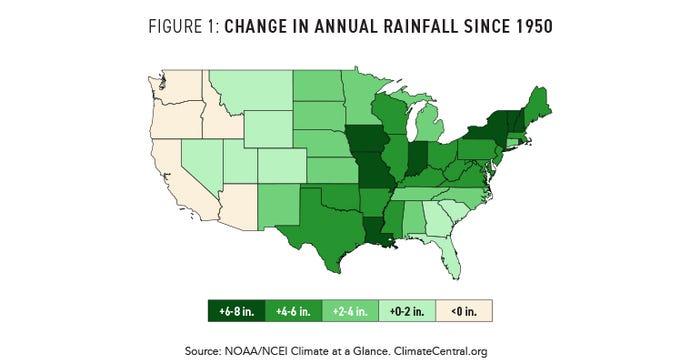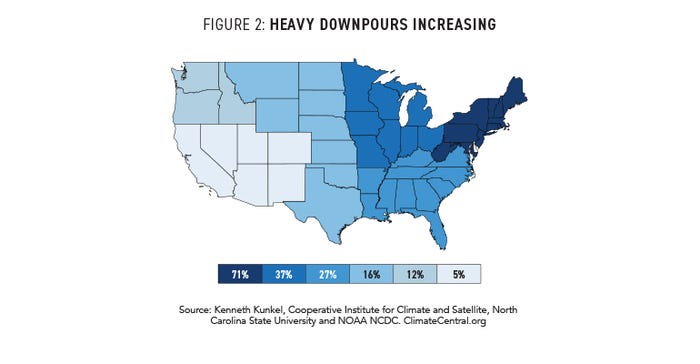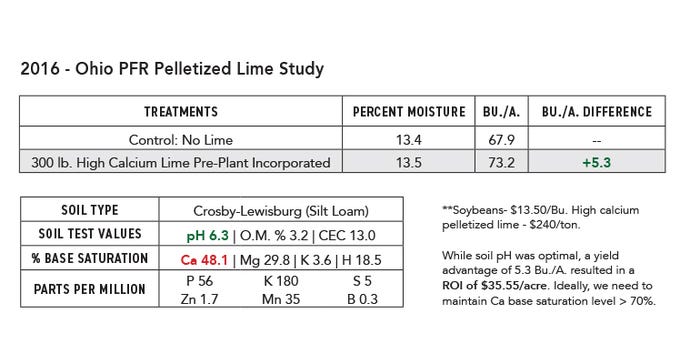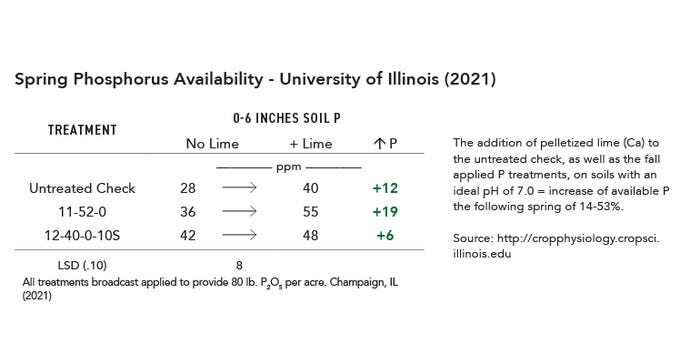January 1, 2023

In these times of unusually high input prices and commodity price uncertainty, crop input selection becomes even more crucial. Often, as we feel pressure to tighten our belts regarding input decisions, we resort to scrutinizing those that are less visual and believed to be less impactful.
For example, altering a herbicide program or lowering the amount of applied nitrogen (N) will often visually show the impact of our decision. That said, managing soil fertility is one of those inputs where “pulling back” is not as obvious as to the impact. Over the years, annual rainfall accumulation throughout the corn belt has increased modestly (Figure 1.)

Photo Submitted by Beck's Hybrids
However, the intensity of that rain has increased dramatically (Figure 2.) As difficult as recent springs have been to complete fieldwork, climatologists project spring precipitation to continue to increase as well. Currently, we are faced with rising fertilizer prices, more violent rain events, fewer spring days to complete fieldwork, and perhaps the most impactful — sustained periods with limited soil oxygen.

Photo Submitted by Beck's Hybrids
HOW CAN WE ADAPT?
As soil fertility inputs are evaluated, it’s important to keep in mind how evolving weather patterns impact soil oxygen and, ultimately, nutrient availability and water infiltration. Contrary to what may appear to be the case throughout some agronomic textbooks, soil fertility is not quite as simple as a mathematical equation. The state of crop nutrients, available vs. unavailable or “tied up,” is continually evolving. Take soil test phosphorous (P), for example. The average volume of P that leaves the field the year immediately following a P fertilizer application is approximately 17-18%. In relative terms, if we apply 200 lb. 11-52-0,
Where did the remaining ~ 160 lb. go? The remaining P largely contributes to the organic phosphorus (OP) pool and is temporarily unavailable. OP accounts for approximately 30-65% of all soil P. This is the same as having an operating loan of $100,000 on which you are paying interest but have access to only approximately $20,000. Oxygen is required for soil microorganisms to convert OP to plant-available phosphorous.
One of the primary mechanisms for maximizing nutrient availability is by closely monitoring soil test calcium (Ca) levels. Years ago, simply maintaining soil pH often meant Ca levels were sufficient or nearly adequate. However, as the clean air act has led to reduced sulfur deposition, thus less acidic rain, soil pH is not declining as rapidly. The need to apply lime or Ca to maintain pH has also declined. In the 1980s, the pH of our rainwater was 4.0-4.5. Today it is much higher. I’ve been testing the rainwater at our home in central Ohio throughout the spring and summer for two years and have never found the pH to be less than 6.2. High calcium lime is an excellent source of Ca. However, as soils require fewer lime applications to elevate pH, what are soil test Ca levels doing? No longer can we simply rely upon maintaining soil pH to also provide sufficient Ca to maximize soil functionality. Think of it this way: the higher the base saturation Ca level, the higher the soil oxygen content. The evidence?


Photos Submitted by Beck's Hybrids
Why did the addition of Ca lead to a yield benefit or increase in nutrient availability when the soil pH was already optimal?
↑ Ca = ↑ soil oxygen = ↑ soil microbial activity → converting OP to plant-available P
↑ Ca = ↑ microbial activity → improved aggregate stability/soil structure → increased water infiltration
↑ water infiltration → reduced soil crusting
↑ water infiltration throughout the soil profile = ↓ seedling diseases
↑ oxygen = ↑ soil biological activity = ↑ nutrient release = ↓ dependency on applied nutrients
The bottom line is, as large rains become increasingly common, soil oxygen is inherently the most yield-limiting element year in, year out. Maximizing soil functionality and reducing dependency on applied nutrients largely comes down to maintaining soil oxygen. Products to influence soil Ca levels include pelletized lime, high calcium ag lime, and gypsum.
Beck's - Farmers At Heart® - revolutionized the customer seed buying experience by remaining true to a foundation built on faith, family, and farming. Founded in 1937, Beck's appreciates the farmers who have helped them become the largest family-owned retail seed company and the third largest seed brand in the United States. The Beck family is now in its fifth generation of family members who work in the business to honor God and help farmers succeed. The Beck family and team of employees help farmers achieve success from generation to generation through authentic customer experiences, product diversity, seed quality, and performance. With a home office located in Atlanta, Ind., Beck's serves farmers throughout the Midwest and Mid-South. For more information about Beck's Superior Hybrids, Inc., visit www.beckshybrids.com.
You May Also Like





